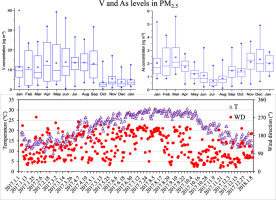当前位置:
X-MOL 学术
›
Atmos. Environ.
›
论文详情
Our official English website, www.x-mol.net, welcomes your
feedback! (Note: you will need to create a separate account there.)
Chemical nature of PM2.5 and PM10 in the coastal urban Xiamen, China: Insights into the impacts of shipping emissions and health risk
Atmospheric Environment ( IF 4.2 ) Pub Date : 2020-04-01 , DOI: 10.1016/j.atmosenv.2020.117383 Shui-Ping Wu , Mei-Jun Cai , Chao Xu , Ning Zhang , Jia-Bin Zhou , Jin-Pei Yan , James J. Schwab , Chung-Shin Yuan
Atmospheric Environment ( IF 4.2 ) Pub Date : 2020-04-01 , DOI: 10.1016/j.atmosenv.2020.117383 Shui-Ping Wu , Mei-Jun Cai , Chao Xu , Ning Zhang , Jia-Bin Zhou , Jin-Pei Yan , James J. Schwab , Chung-Shin Yuan

|
Abstract With objective of estimating the impact of ship emissions on ambient PM2.5 and PM10 levels and human health at a coastal urban site in Xiamen Island, a one year long sampling campaign was carried out from January 2017 to January 2018. Samples were subject to chemical analysis for various chemical components including water-soluble inorganic ions, carbonaceous species, and elements. The annual average PM2.5 and PM10 mass concentrations were, respectively, 32.8 ± 18.9 μg m−3 and 54.5 ± 29.6 μg m−3. The highest seasonal average concentrations were found in winter-spring and the lowest in summer due to the seasonal monsoon and gas-particle conversion. The rapid accumulation of vehicle exhaust and the stable existence of NH4NO3 in the ground layer within the urban area contributed to the incremental PM. Sulfate, nitrate, ammonium and organic carbon in PM2.5 have decreased since 2011–2013, while elemental carbon increased significantly. This suggests that the motor vehicle and/or ship emissions contributions to PM2.5 have increased relative to coal combustion over the past five years. The temporal variations of PM and its associated components during the BRICS summit control period further confirmed the important role of traffic related emissions in PM mass. Primary particulates resolved by PMF analysis plus secondary sulfate derived from secondary sulfate formation were estimated to account for 7.56% and 8.31% of PM2.5 and PM10, respectively. Selected heavy metals (As, Cd, Ni, V, Mn, hexavalent Cr, Ba and Pb) originating from ship emissions contributed 64.4% for PM2.5 and 53.2% for PM10 of the total non-cancer risk. Carcinogenic risk (lifetime cancer risk) for ship emissions associated with these hazard metals accounted for 50.6% for PM2.5 and 44.5% for PM10. Therefore, control measures applied to the ship emissions can benefit the local air quality improvement and reduce health burden to people around the port.
更新日期:2020-04-01











































 京公网安备 11010802027423号
京公网安备 11010802027423号